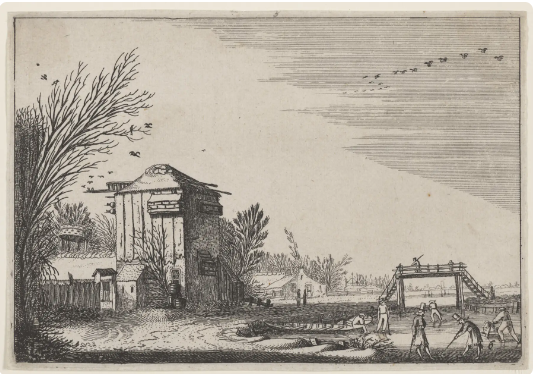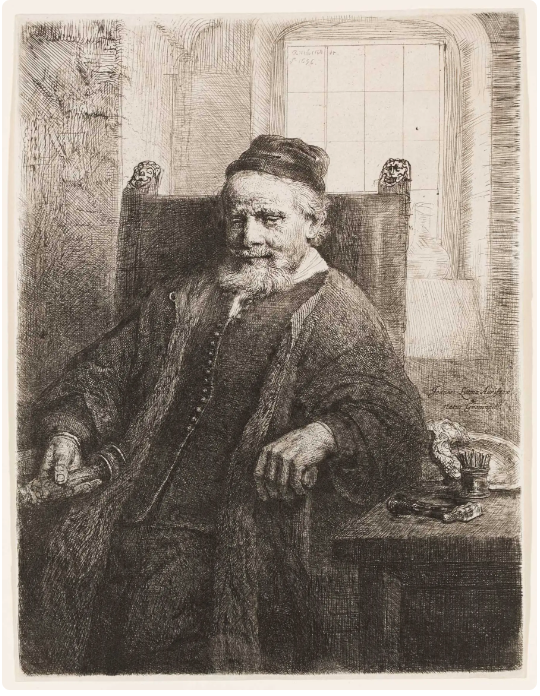|
Milwaukee Art Museum
Life Captured in Line: 17th Century Dutch and Flemish Paintings through September 18, 2024 Print culture flourished in the North and South Netherlands during the 17th century as the region became the epicenter of printing and publishing in Europe. Artists such as Rembrandt van Rijn, Jan Van de Velde, and Cornelis de Visscher participated in the influx and exchange of ideas that the industry fostered and created prints in an expansive variety of genres, styles, and techniques. Featuring works drawn from the Museum’s collection, this exhibition builds on themes presented in Art, Life, Legacy: Northern European Paintings in the Collection of Isabel and Alfred Bader, highlighting subjects popular in printmaking at the time, including biblical scenes, landscape, and portraiture. image top right: Jan van de Velde II (Dutch, ca. 1593–1641), A Winter Landscape with Skaters on a Canal, from the series Landscapes, 1616. image right: Rembrandt van Rijn, Jan Lutma, Goldsmith, 1656. ALSO ON VIEW
50 Paintings through June 23, 2024 Beyond Heights: Skyscrapers and the Human Experience through September 8, 2024 |
Art Institute of Chicago

Georgia O’Keeffe: “My New Yorks” through September 22, 2024
Famed for her images of flowers and Southwestern landscapes, Georgia O’Keeffe spent several years exploring the built environment of New York City with brush in hand. The artist first moved to the city’s newly built Shelton Hotel in 1924, then the tallest residential skyscraper in the world, and its soaring heights inspired a five-year period of energetic experimentation, across media and at a variety of scales, with subject matter, form, and perspective.
She created street-level compositions capturing the city’s monumental skyscrapers from below and suspended views looking down from her 30th-floor apartment. O’Keeffe called these works “my New Yorks” and through them investigated the dynamic potential of New York’s cityscape—the organic and the inorganic, the natural and the constructed. As she put it, “One can’t paint New York as it is, but rather as it is felt.”
This exhibition is the first to seriously examine O’Keeffe’s paintings, drawings, and pastels of urban landscapes, while also situating them in the diverse context of her other compositions of the 1920s and early 1930s.
Famed for her images of flowers and Southwestern landscapes, Georgia O’Keeffe spent several years exploring the built environment of New York City with brush in hand. The artist first moved to the city’s newly built Shelton Hotel in 1924, then the tallest residential skyscraper in the world, and its soaring heights inspired a five-year period of energetic experimentation, across media and at a variety of scales, with subject matter, form, and perspective.
She created street-level compositions capturing the city’s monumental skyscrapers from below and suspended views looking down from her 30th-floor apartment. O’Keeffe called these works “my New Yorks” and through them investigated the dynamic potential of New York’s cityscape—the organic and the inorganic, the natural and the constructed. As she put it, “One can’t paint New York as it is, but rather as it is felt.”
This exhibition is the first to seriously examine O’Keeffe’s paintings, drawings, and pastels of urban landscapes, while also situating them in the diverse context of her other compositions of the 1920s and early 1930s.
ALSO ON VIEW
Christina Ramberg: A Retrospective
through August 11, 2024
Four Chicago Artists: Theodore Halkin, Evelyn Statsinger, Barbara Rossi, and Christina Ramberg
through August 26, 2024
Threaded Visions: Contemporary Weavings from the Collection
through August 26, 2024
Christina Ramberg: A Retrospective
through August 11, 2024
Four Chicago Artists: Theodore Halkin, Evelyn Statsinger, Barbara Rossi, and Christina Ramberg
through August 26, 2024
Threaded Visions: Contemporary Weavings from the Collection
through August 26, 2024
|
Christine Ramberg. Parallel Manipulation, 1977. Gift of the Roberta A. Lewis Fund in memory of William and Polly Levey. © The estate of Christine Ramberg
|
Theodore Halkin. Untitled, 1968. GIft of Daniel Halkin and Sylvia Halkin in memory of Theodore Halkin.
|
James Bassler. A Weaving (detail), 2012. The Art Institute of Chicago, Christa C. Mayer Thurman Textile Endowment. © James Bassler.
|
Saint Louis Art Museum

Art and Imagination in Spanish America 1500-1800:
Highlights from the LACMA Collection to September 1, 2024
This exhibition features more than 100 works drawn from the Los Angeles County Museum of Art’s notable collection of Spanish colonial art, which has largely been formed in the last fifteen years. The paintings, sculptures, and decorative arts on view underscore the generative power of Spanish America and its central position as a global crossroads.
Imperial expansion, conquest, colonization, and the trans-Atlantic slave trade marked the period spanning from 1500 to 1800. Cataclysmic social and geopolitical shifts brought people into closer contact than ever before in real and imagined ways, propelling the creative refashioning of the material culture that surrounded them. After the Spaniards began colonizing the Americas in the late 15th century and set out to spread Christianity, artists working there drew from a range of traditions—Indigenous, European, Asian, and African—reflecting the interconnectedness of the world. Private homes and civic and ecclesiastic institutions soon teemed with imported and local objects.
Spanish America was neither a homogeneous nor a monolithic entity, and local artists, including those who remain unidentified, were not passive absorbers of foreign traditions. While acknowledging the profound violence that marked the process of conquest and colonization, this exhibition explores the intricate social, economic, and artistic dynamics of these societies that led to the creation of astounding new artworks that were widely sought after and shipped around the world.
This exhibition was organized by the Los Angeles County Museum of Art.
Art and Imagination in Spanish America, 1500–1800 is presented in St. Louis with generous support from the Betsy & Thomas Patterson Foundation.
image above: Unidentified artist, Southern Andes; Poncho with Musicians (Poncho con músicos), late 17th–early 18th century; cotton, camelid-fiber, and silk and metallic-thread tapestry weave; 69 1/2 x 66 inches; Los Angeles County Museum of Art, Gift of Miss Bella Mabury M.40.1.76; photo © Museum Associates/LACMA
Highlights from the LACMA Collection to September 1, 2024
This exhibition features more than 100 works drawn from the Los Angeles County Museum of Art’s notable collection of Spanish colonial art, which has largely been formed in the last fifteen years. The paintings, sculptures, and decorative arts on view underscore the generative power of Spanish America and its central position as a global crossroads.
Imperial expansion, conquest, colonization, and the trans-Atlantic slave trade marked the period spanning from 1500 to 1800. Cataclysmic social and geopolitical shifts brought people into closer contact than ever before in real and imagined ways, propelling the creative refashioning of the material culture that surrounded them. After the Spaniards began colonizing the Americas in the late 15th century and set out to spread Christianity, artists working there drew from a range of traditions—Indigenous, European, Asian, and African—reflecting the interconnectedness of the world. Private homes and civic and ecclesiastic institutions soon teemed with imported and local objects.
Spanish America was neither a homogeneous nor a monolithic entity, and local artists, including those who remain unidentified, were not passive absorbers of foreign traditions. While acknowledging the profound violence that marked the process of conquest and colonization, this exhibition explores the intricate social, economic, and artistic dynamics of these societies that led to the creation of astounding new artworks that were widely sought after and shipped around the world.
This exhibition was organized by the Los Angeles County Museum of Art.
Art and Imagination in Spanish America, 1500–1800 is presented in St. Louis with generous support from the Betsy & Thomas Patterson Foundation.
image above: Unidentified artist, Southern Andes; Poncho with Musicians (Poncho con músicos), late 17th–early 18th century; cotton, camelid-fiber, and silk and metallic-thread tapestry weave; 69 1/2 x 66 inches; Los Angeles County Museum of Art, Gift of Miss Bella Mabury M.40.1.76; photo © Museum Associates/LACMA
ALSO ON VIEW
Romare Beardon: Resonances through September 15, 2024
Concealed Layers: Uncovering Expressionist Paintings through August 4, 2024
Shimmering Silks: Traditional Japanese Textiles, 18th-19th Centuries through October 20, 2024
Romare Beardon: Resonances through September 15, 2024
Concealed Layers: Uncovering Expressionist Paintings through August 4, 2024
Shimmering Silks: Traditional Japanese Textiles, 18th-19th Centuries through October 20, 2024
left: Romare Bearden, American, 1911–1988; Summertime (detail), 1967; collage on board; 56 x 44 inches; Saint Louis Art Museum, Museum Minority Artists Purchase Fund 22:1999; © 2024 Romare Bearden Foundation / Licensed by Artists Rights Society (ARS), New York
center: Ernst Ludwig Kirchner, German (active Switzerland), 1880–1938; Portrait of Gerti, dated 1907 [1910-11]; oil on canvas; 31 3/4 x 27 3/4 in. (80.6 x 70.5 cm); Saint Louis Art Museum, Given by Sam J. Levin and Audrey L. Levin 26:1992
right: Japanese; Hanging with Design of Dragon and Phoenix amidst Waves and Clouds, late 19th century; silk with silk embroidery and metallic-wrapped threads; overall: 72 1/2 x 52 1/4 inches, image: 61 x 39 3/8 inches; Saint Louis Art Museum, Gift of Mrs. Alexander B. Pierce 253:1951
center: Ernst Ludwig Kirchner, German (active Switzerland), 1880–1938; Portrait of Gerti, dated 1907 [1910-11]; oil on canvas; 31 3/4 x 27 3/4 in. (80.6 x 70.5 cm); Saint Louis Art Museum, Given by Sam J. Levin and Audrey L. Levin 26:1992
right: Japanese; Hanging with Design of Dragon and Phoenix amidst Waves and Clouds, late 19th century; silk with silk embroidery and metallic-wrapped threads; overall: 72 1/2 x 52 1/4 inches, image: 61 x 39 3/8 inches; Saint Louis Art Museum, Gift of Mrs. Alexander B. Pierce 253:1951
Illinois State Museum, Springfield, Illinois

NOIR IV: Landmarks through Labor Day Weekend 2024
The Illinois State Museum, in collaboration with Juneteenth, Inc., will present NOIR IV: Landmarks, an exhibition of artists representing Black art and culture curated by co-curators Alyssa Farmer and Austin Wells. The exhibition will be featured at the Dana-Thomas House State Historic Site from June 14th through Labor Day Weekend.
The Dana-Thomas House State Historic Site is located at 301 E Lawrence Ave, Springfield, IL 62703.
Wednesdays, 9:00 a.m. - Noon, Fridays, 5:00 - 7:00 p.m., Saturdays, 9:00 a.m. - Noon
The Illinois State Museum, in collaboration with Juneteenth, Inc., will present NOIR IV: Landmarks, an exhibition of artists representing Black art and culture curated by co-curators Alyssa Farmer and Austin Wells. The exhibition will be featured at the Dana-Thomas House State Historic Site from June 14th through Labor Day Weekend.
The Dana-Thomas House State Historic Site is located at 301 E Lawrence Ave, Springfield, IL 62703.
Wednesdays, 9:00 a.m. - Noon, Fridays, 5:00 - 7:00 p.m., Saturdays, 9:00 a.m. - Noon







